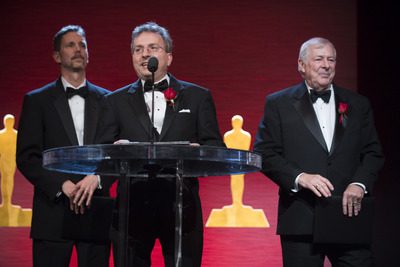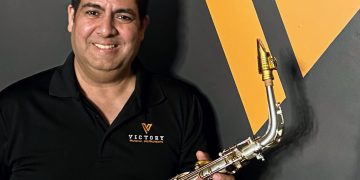
50 Years of Innovation and Commitment to Customer Service
In its first half-century, New Mexico-based Lectrosonics has firmly established itself as a go-to brand for the music, theater tech, film, and broadcast communities. The company’s wireless systems and signal processing gear are relied upon by audio engineers the world over.
We recently sat down with vice president of sales & marketing, Karl Winkler, to discuss Lectrosonics’ history, milestone moments, and plans – eventual plans – to celebrate this significant anniversary.

Can you talk about the origins of Lectrosonics? Who were the principals/founders back in May, 1971? How big was the first facility in Albuquerque? How many employees, total, were on board in the beginning?
The company founders were Tom Gilmer and Paul Auxter. They had come from Singer Business Machines, a company making computers, with a branch here in Albuquerque. The company started with a dozen employees and the first facility was a rented Quonset Hut that had been a metal reclamation operation before we moved in. In other words, not quite a garage, but not much better than that!

What was the catalyst behind the Voice Projector?
The Voice Projector was an established product out of California, and Lectrosonics started by licensing it. The concept was simple – make a “bullhorn” with a detachable microphone, giving the product some flexibility over what was available at the time. This really led to a whole series of portable, rechargeable lecterns and related products, designed for traveling salespeople, teachers, and the like.
For those unfamiliar, what were “The Mouse Years” at Lectrosonics?
The Mouse amplifier series was an outgrowth of the technology developed for the lecterns, but of course aimed at the musician market. Once again, the idea was fairly simple, but the trick was in the execution. The Mouse was a portable, rechargeable guitar amplifier designed for street musicians, café performers, et cetera. It offered a proper guitar input with a bit of EQ for tone adjustment, a small but efficient speaker, and in later models, an aux input. The most popular model in the series by far was the MaxiMouse – a high powered version with two inputs – one for guitar and one for a microphone. We also made the Moose – a bass amplifier made on the same concept. For a couple of decades, and still seen occasionally today, these units were the darlings of buskers everywhere. One even makes a cameo appearance in “School of Rock” when the kids are in the van coming back from the Battle of the Bands audition when they “stuck it to the man.”

As the product offerings expanded, what were some significant introductions that really helped define and grow Lectrosonics in the ‘80s and ‘90s?
The Long Ranger was the longest-running of all the amplifier products, introduced originally as the VP300 in the early 1980s and finishing as the Long Ranger IV in 2011. This high-powered, high-efficiency horn-based vocal amplifier was very popular for auctioneers, law enforcement, and military customers (known as the Sound Commander). The CR185/M185 portable wireless system developed in the mid-1980s and introduced at the NAB show in 1988 was a huge seller for Lectrosonics, and ended up defining what a high-quality, portable wireless system could do. In many ways, it transformed electronic news gathering as we know it. The 190 Series in the 1990s became the portable wireless of choice for filmmakers. The IS400 instrument wireless system in the mid 2000s re-defined what a quality wireless could do for guitars and bass instruments – artists from Slash to Neal Schon to Eva Gardner, AC/DC, Alex Lifeson, and many others switched to Lectrosonics wireless during this time. The TM400 System for wireless measurement & sound system alignment has become the standard of the touring industry. And, the Digital Hybrid Wireless® in general received an Academy Award in 2017, after being used in the production of nearly every Hollywood feature film during the previous decade.

Can you talk about the move to Rio Rancho?
In 1987, then company president John Arasim was looking for a new location. At the time, Rio Rancho was a desolate development of mostly cheap houses, but the town was looking to increase their tax base with some light industrial companies. Lectrosonics bought a generous plot of land, built a building, and moved in during 1988.

As the company entered the new millennium and through to the present day, what were some milestone achievements or Lectrosonics?
We’ve very proud of the industry awards we’ve received over the years, including two Cinema Audio Society awards, and various trade magazine and trade show awards for new products from NAMM to NAB to InfoCOMM. Probably the most exciting is that our patented Digital Hybrid Wireless® platform, introduced originally in 2002, received an Academy Award in 2017, after being used in the production of nearly every Hollywood feature film during the previous decade. Our entry in the Broadway theatrical market in 2016/17, based on the tiny SSM transmitter, was very exciting as well.
At present, how many employees are on staff?
140
Any recent or upcoming product introductions or developments you’d like to draw MMR readers’ attention to?
Our line of digital wireless microphones, based around the D Squared platform, offers RF performance and sound quality not found in any other system available. There are rack and portable receivers, handheld, bodypack and plug-on transmitters, and the system is backward compatible with the previous generation Digital Hybrid systems. We encourage your readers to give this system a trial if they are looking for top-quality wireless microphones.

Does Lectrosonics have any 50th anniversary events or promotions planned?
We’re keeping things fairly quiet as the pandemic is still going on out there. We do have a company celebration planned for later in the year once everyone here is vaccinated. We may have a special event at the next live trade show – we’ll see!
Expectations for the future?
We expect to keep growing, investing in our technology and people, and continuing to manufacture Lectrosonics products in the USA. As a privately held company, and “pro only,” we can focus on high-tech solutions to challenging problems our customers face in doing their work as musicians, cinematographers, houses of worship, theaters, and touring sound professionals. We look forward to continuing and growing those relationships


























Looking Back on 2025: A Year of Controlled Chaos (Emphasis on “Controlled”)